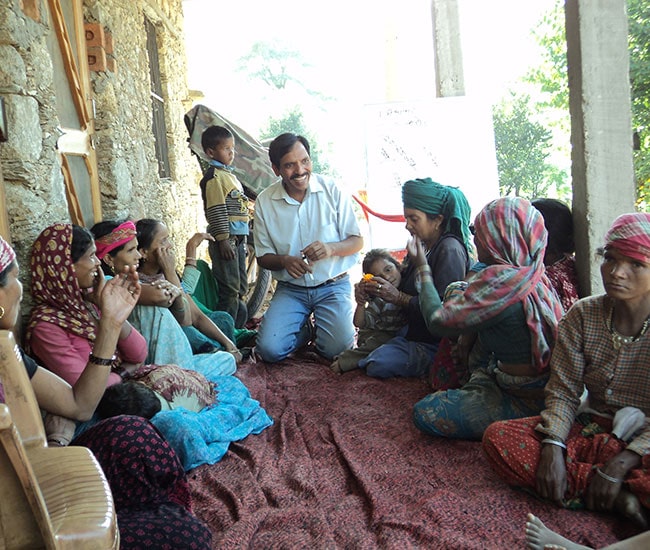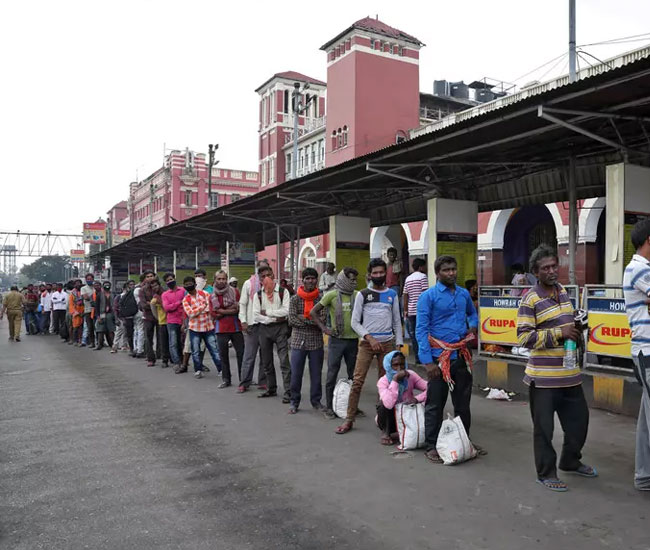
Satark Nagrik Sangathan
Background
Formed in 2003, Satark Nagrik Sangathan (SNS) aims to plug the gaps in transparency and accountability in governance, and does so with the help of the Right to Information (RTI) Act. Working primarily among the lower income groups of five slums settlements in South Delhi, SNS takes up issues pertaining to the basic needs and entitlements of the people. With information as the keystone in empowering a society for it to be able to make informed decisions and thus demand what is rightfully its own, the sangathan seeks to effect change in the larger context, by pressing for the need of information to be made public and easily accessible to people from different strata of society. Founded by five people, the sangathan today has eight core members, and its growth has been steady, without any blindly set targets of maximising its expanse or having ambitious work plans. SNS follows the dictum of listening to the people, and then work its way through driving the people’s agendas.
The Birth of SNS
In the 1990s, in an attempt to tackle the beast of corruption, Anjali and other like minded individuals turned to the RTI Act. The main issue was that there was no transparency in the way the system worked making it very easy for people in the government to siphon off funds that were meant for citizens. People in Rajasthan had begun to use the RTI, asking for information and linking it up to their wages. It sounded like a very potent and useful tool in the struggle to demand one’s rights and entitlements from the State.
In 2003, when Anjali was set up SNS and started activities in five slum clusters of the Malviya Nagar and Hauz Khas constituencies of Delhi—Jagdamba Camp, Malviya Nagar Corner, Begumpur, Lal Gumbad and Swami Nagar. However, the idea that information could actually transform one’s life was an abstract concept. To concretize the idea, she and her colleagues first took up the issue of ration, asking people to question why they were not getting their share of ration. (The First Challenge) A few women came forward and agreed to file RTI applications in the food department, asking to see the records of the fair price shop (FPS) to which their ration card was linked; they asked for a copy of the stock and sale registers of the past two years. The government then had no option but to share that information. This entire information was then shared with others who were not receiving ration, and thus started a movement. About 500 mass complaints were filed in the Food and Civil Supplies Department.
The Crucial Jan Sunwai of July 2004
A jan sunwai (public hearing) was organized in July 2004 where all the senior officials from the ration department, as well as owners of FPS and representatives of the media were invited. About 500 people living in the vicinity attended the hearing and publicly discussed the records, questioning the officials and dealers on the discrepancies. The effect of the jan sunwai was that suddenly, 95 per cent of the people all across the city who were not receiving ration began to get their due. FPS owners pulled up their socks before information regarding their shops was sought. Now there was the scenario where people could hold officials accountable and the myth that people were not empowered was broken.
Some people then come forward to SNS to get their children’s birth certificate made (The Struggle for Birth Certificates); in 2005 the issue of education was raised. Later, as per the Right to Education, private schools had to reserve 25 per cent of their seats for children from the economically weaker sections (EWS), and the struggle was to ensure that the children from the slums would get admitted to private schools. By 2007 SNS began to talk about the non receipt of pensions.
When SNS conducts capacity building trainings, even those women who one could write off as illiterate and ignorant, would come for those trainings to learn about RTI. When the sangathan would ask why they want to learn about RTI, they would reply that it was associated with every realm of life. They understand that its use can be diverse. It is a system that puts people in the heart of things and doesn’t allow the opportunity to leave people out. For people who are learning more about the Act and are using it, it is a life altering process for them. It is also effective in changing the balance of power.
Accountability from the elected representatives
Issues that SNS works on are related to service delivery and building capacity among the people to claim them. People started observing in the meetings that this was a great tool to check accountability. They said that the ministers visited them once in five years just before elections when they have to canvass for votes, after which there was no information on what was done once they are elected. So people asked if they could invoke the RTI to know what ministers really do.
SNS filed applications about the stated roles and responsibilities of the MLA, Councillor and MP. Finally, after the applications had travelled through various offices, a reply was received after a year which stated that there were no such roles and responsibilities. They then sat down with the Constitution of India, the People’s Representations Act, Assembly Rules, the Municipal Act, and then created small pamphlets mentioning the primary roles and responsibilities of MLAs, Councillors and MPs.
In 2006-7, SNS filed RTI applications for all the 70 MLAs in Delhi, asking for a report of all the work that they had been doing in the previous 5 years. SNS then organised several meetings in all the five slums, giving information about all the work the MLA had done or not done, about the number of times he attended the Assembly, the number of times he raised questions on various issues, money spent on projects, etc. This was the first campaign of its kind in India wherein the Act was being used to demand information about the functioning of politicians. (Report Cards for MLAs & MPs)
SNS then began lobbying with the government that all this information should be out suo moto. So on February 11, 2011, the Central Information Commission passed orders stating that in all the 272 wards in Delhi, boards should be put up in Hindi, in prominent public places giving information on how the LAD had spent in that year. That now puts pressure because an MLA cannot leave that space blank, and can also be careful about the way he spends the funds.
SNS has helped people make the linkages between the RTI, their fundamental rights and entitlements, and the issue of accountability of the administration and their elected representatives. The work of the sangathan has also fore grounded the larger concern of where people figure in the whole scheme of governance, the space that a citizen has and how that space could be claimed.
Stories
The First Challenge
When SNS was started, Anjali and her colleague Ashok would go to slums like Jagdamba Camp for weekly meetings. They would put up the sangathan’s banner on a wall and sit next to it waiting to help anyone. This continued for about 7 months. While people would listen to them patiently during the meetings, none of them were convinced enough to approach them for help with the RTI.
Then a mahila mandal was organised and some vocal women from the slum were made the office bearers. This was a way to get them to attend the meetings on a regular basis and encourage other people from the slum to put forth their grievances. The sangathan had assumed that the core issues to be tackled were water and cleanliness. But when they would talk about cleanliness, people stopped coming to the meetings. People began to bring to the fore their problem of not being able to access ration despite having a ration card for several years. The sangathan realised that the only way to work with people is to tackle the issues bothering them. While there were three types of ration cards made in 2002, meant for people of different income levels, people using the red card (people who are below-poverty-line or BPL) didn’t even know the rate at which they were supposed to receive their ration.
So SNS along with people from the slums began to make rounds to the ration shop or the oil depot. At both places, there was no rule of law. The dealers were confident that their theft would never come to light as nobody would dare ask them about their record books. When the people filed an RTI application, they found that the stock registers showed that every month ration was reaching the Fair Price Shop, while the sale registers were a complete work of fiction. They had names of people who didn’t exist; they had card numbers which did not match with any card number anywhere at all. There were thumb prints against the names of those people who would usually sign!
The Struggle for Birth Certificates
Many of the children in the slums did not have birth certificates. Even the concept was unknown to the parents. But to get the children admitted to a school, the birth certificate had to be produced. The pradhan of the slum (who acts as an unofficial intermediary between the government and the people) insisted that he could help, but the parents would have to shell out Rs 1,500.
It was through SNS that Pushpa, one of the karyakartas of the sangathan, learnt that one could get the birth certificate made with the help of the SDM. But approaching the SDM was an issue. She somehow convinced 18 other women to walk up to the SDM with her, all of who also wanted to get certificates made for their children. Once the applications were filed at the SDM’s office in 2004, a team was sent into the basti for enquiry. “We were asked to bring forth proof of the child’s birth, but we protested that a woman alone could best testify about her child. But the team insisted that men be involved in the process of providing testimony. Incidentally, one of our meetings was on at that time, and when we went up to the meeting to narrate this tale, we were told by SNS that we ought to fight for our testimony—there was no way that a woman’s testimony could be refuted,” Pushpa says.
Feeling charged with the encouragement, Pushpa and the 18 other women went on to talk to the police, asking them to show written documents which would assert that women’s testimony would not be accounted. While the police personnel began to question her place of origin and morality, Pushpa countered his words rationally and fearlessly.
Report Cards for MLAs & MPs
When SNS filed RTI applications to find out what the 70 MLAs in Delhi had been doing, they found that the Begumpur MLA had spent 40 per cent of his allotted funds on establishing artificial fountains and waterfalls, whereas people in the area hadn’t been receiving drinking water since 7 years! Water would be available at 2 am and all the women and girls would line up from midnight. This gave rise to many law and order problems. Despite repeated requests to the MLA, he would say that he has no funds and wouldn’t be able to spend money from his own pocket. People then took the utilisation information and went up to the MLA, and told him not to step into their homes asking for votes since he had been fooling them for 7 years. He is entitled to receive Rs 2.5 crore every year as Local Area Development (LAD) funds, and thus received Rs 12.5 crore from the government over a period of five years. Worried about losing his vote bank, the MLA soon set up tube wells in Jagdamba Camp and Begumpur.
The sangathan then tied up with NGOs to disseminate this information, as well as with mainstream media—TOI in English and Hindustan in Hindi. The format of a report card for all the 70 MLAs in Delhi was created which showed through a pie chart projects taken up and their corresponding expenditure, attendance at the Assembly sessions and number of questions raised. One MLA who hadn’t asked any questions did not receive the ticket to stand for the next elections. It was a way in which people could engage with their representatives based on objective information. One MLA called up SNS to say that if he had known that report cards would be published, he would have gone to the Assembly more regularly.
The report card exercise was also carried out in Jharkhand and Bihar before state elections. The response was encouraging as people felt that they were now in the know when it came to their elected representatives. People in the five slums in Delhi put up banners saying ‘We don’t want money; we don’t want alcohol; only he who solves our problems will get our vote’. The candidates for MLAs in those areas began to expect questions from citizens instead of flower garlands and obeisance.


